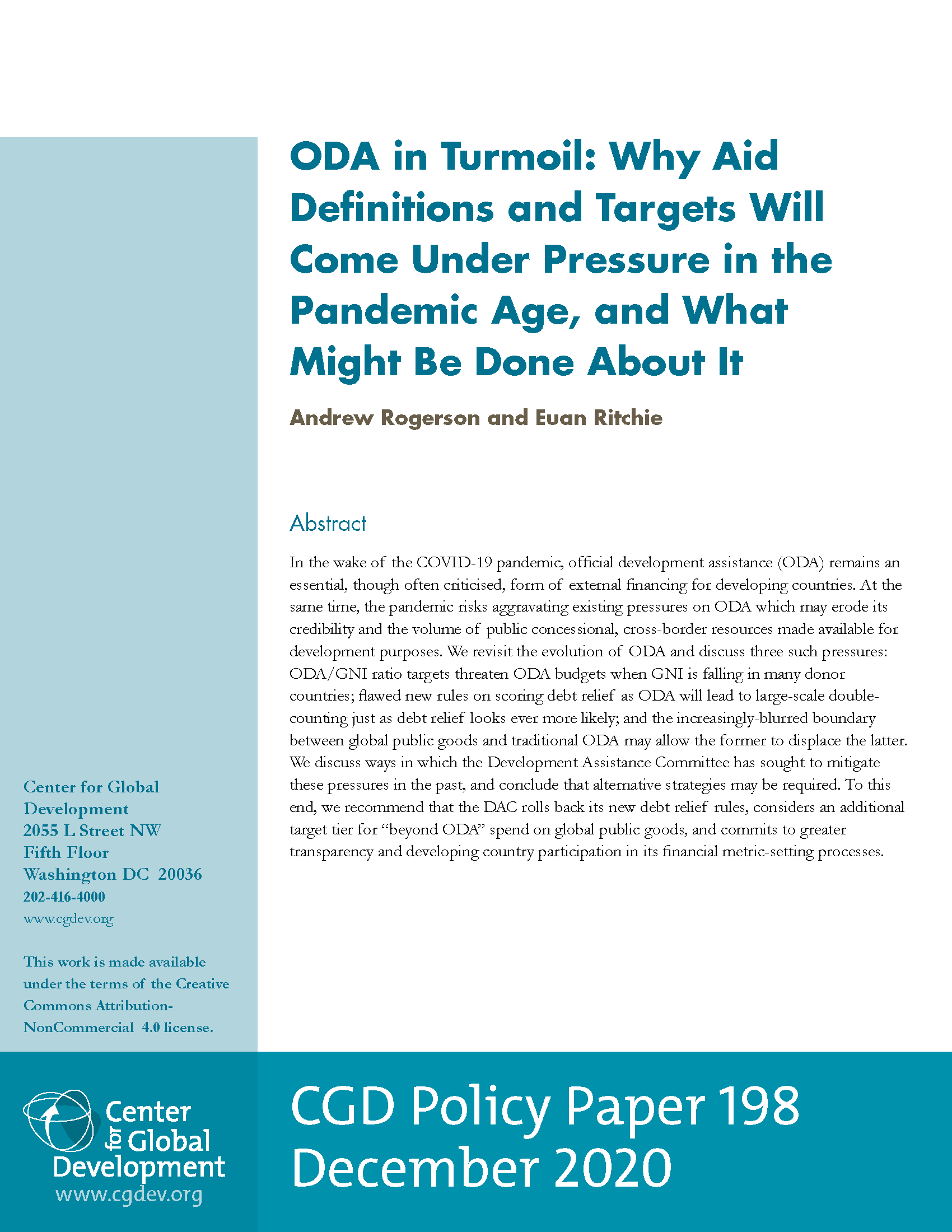Recommended
With a new US administration rejoining the Paris Agreement and the upcoming Glasgow climate conference set to endorse a new set of national commitments to greenhouse gas emissions, there is renewed momentum in the struggle to limit climate change and its global impact. But global finance to support mitigation and adaptation in developing countries is still inadequate and misdirected. A climate-dedicated capital increase at the World Bank Group would be a comparatively low-cost way to considerably improve the volume and quality of climate finance.
Reducing greenhouse gas emissions is a matter of national self-interest and global equity: climate change will have some of its worst effects in the world’s poorest countries, which have contributed the least to the stock of emissions. At the same time, richer developing countries in particular need to be part of the solution if emissions are to sustainably decline: low and middle income countries as a whole are forecast to account for about 80 percent of the growth in the world economy, and the predominant share of global infrastructure investment. As a result, they will account for roughly 70 percent of global energy demand in 2050, for example.
Because richer countries are responsible for far higher emissions per person as well as most of the stock of global greenhouse emissions, it has long been accepted that they should support poorer countries in the transition to low-carbon economies in a warming world. The Copenhagen climate conference in 2009 set the goal of $100 billion a year in climate financing by 2020. This was considered a “floor” on which future conferences would build.
The OECD suggests we saw about $79 billion in new and additional climate finance in 2018, although those numbers are contested, complicated by the fact that neither the Copenhagen meeting or its successor in Paris defined precisely what new and additional meant or a baseline year.
But it is clear that donors are using about $36 billion in ODA help to meet climate commitments, mostly on mitigation in richer developing countries, which has contributed to a reduction in the absolute volume of non-climate finance available for humanitarian relief and poverty reduction programs including health, education and infrastructure in the poorest countries. And what we know about the cost-effectiveness of this aid in terms of mitigation impacts is not reassuring: projects that are tens or hundreds of times less cost-effective than best available in terms dollars per ton of carbon dioxide emissions averted.
Grants are an inefficient and expensive tool to produce mitigation outcomes that should mostly involve the need for finance that is marginally below market cost (because the most efficient methods to reduce greenhouse gas emissions are cost-free or low cost). Finance on somewhat below-market terms is regularly provided by the multilateral development banks and the IFC which use the advantages of scale, diversity and member government guarantee to remain profitable while offering lower interest rates. These institutions are a powerful tool to support mitigation spending in the middle-income countries which will dominate future growth in emissions.
Table One reports on the cost of borrowing from the World Bank compared to the cost of borrowing on markets for a number of IBRD borrowers, as well as their share of greenhouse gas emissions from IBRD countries as a group. The data covers countries responsible for 73 percent of IBRD borrower country emissions. As is clear, IBRD borrowing terms are currently not attractive for China, which can borrow more cheaply from the markets and accounts for 42 percent of IBRD emissions. It’s equally clear the China’s progress on climate mitigation no longer depends on World Bank support. But for all other countries in the list, IBRD borrowing is cheaper than market borrowing. Weighted by their share of emissions, the countries in the table can borrow from the IBRD at an average 1.9 percent discount from the market.
The World Bank Group has already moved toward a greater role in climate finance under the 2018 capital increase, when shareholders agreed the climate-related share of the IBRD’s portfolio would rise from the 21 percent to 30 percent and the IFC’s share to 35 percent. The increase also came with commitments to screen all bank projects for climate risks and incorporate a carbon shadow price into the economic analysis of projects in emissions-producing sectors. At some point, all of the Bank Group’s finance will likely become Paris-aligned and future general capital increases may well involve commitments around emissions –perhaps net carbon neutrality.
The UN Independent Expert Group on Climate Finance has called for further multilateral development bank capital increases linked to climate. A climate-dedicated increase would build on that idea and the Bank’s last capital increase. It would provide finance solely for World Bank and IFC investments that would have a significant mitigation impact on greenhouse gas emissions compared to business as usual. These projects (or programs) would be part of climate finance over and above existing commitments (30 percent of the regular portfolio for the World Bank, 35 percent for the IFC). The projects and programs would have to pass agreed cost-efficiency metrics in terms of abatement impact.
A $13 billion paid-in capital increase in 2018 allowed the World Bank Group to increase lending by an average of about $41 billion annually through 2030. If the same ratio of capital increase to lending capacity applied to a climate round, a $32 billion increase to the capital of the Bank and IFC would allow for $100 billion in additional annual lending through 2030.
As well as being an affordable option for the considerable scaling of climate finance, a capital increase at the World Bank Group ensures a common but differentiated financing responsibility that will minimize the problem of free-riding: almost every economy is a shareholder in the two institutions and larger (richer) economies more responsible for emissions will have to provide the bulk of the capital.
Following the above estimate, the US would be responsible for a little less than $6 billion of the capital increase, China for around $1 billion. If the capital increase was more heavily weighted towards the IBRD, the US contribution would decline. For the US, that means about $1 billion a year over a six-year period, which would represent a significant though by no means a dominant share of what the Biden administration might be expected to commit to global climate efforts.
A climate-dedicated capital increase should also be tied to different thinking on how to allocate the money. The bank’s progress toward more ambitious climate finance targets has to date relied on traditional project finance channels. This will continue to make sense in many cases as countries require both favorable IBRD financing terms and bank staff expertise on various dimensions of project planning and execution. But it’s also the case that many of these large-emission, large-economy developing countries have a much greater need for favorable terms than they do for project level technical support. It is likely that climate mitigation goals could be met more rapidly in these cases if the bank focused squarely on the financing and the policy environment—foregoing traditional project lending in favor of policy-based bond guarantees. The World Bank’s ability to buy down the terms of sovereign bond issuances, linked to binding commitments by the government to allocate proceeds to climate, would appropriately and efficiently incentivize climate investments in a timely manner. A shift away from project lending could also enable a better focus on financing outcomes (in this context, actual reductions in emissions) rather than simply paying for project inputs.
Beyond allowing for a scale-up of new and additional mitigation finance, a climate-dedicated capital increase would provide new impetus and purpose to IFC and World Bank activities in middle income countries where traditional operations are increasingly marginal to overall development outcomes while freeing ODA for adaptation and development purposes in the poorest countries where need and impact is greatest. The proposal is advantageous for donor countries as well as the poorest economies, the World Bank Group itself and, most importantly, progress against climate change.
Table 1. Lending Spreads and GHG Emissions Share
| Country | Sovereign 5 yr USD-denominated bond yield minus IBRD Flexible Loan (IFL) <8 yr variable-spread rate (%) | Percent of total GHG emissions by IBRD-eligible countries (%) |
|---|---|---|
| China | -0.17 | 42.0 |
| Russia | 1.3 | 7.7 |
| Brazil | 2.1 | 3.9 |
| Indonesia | 1.1 | 3.1 |
| Mexico | 1.2 | 2.5 |
| Turkey | 4.6 | 2.1 |
| South Africa | 3.0 | 1.8 |
| Poland | 0.25 | 1.3 |
| Pakistan | 5.0 | 1.3 |
| Egypt | 4.6 | 1.1 |
| Malaysia | 0.45 | 1 |
| Nigeria | 4.3 | 1 |
| Ukraine | 5.5 | 0.88 |
| Philippines | 0.61 | 0.65 |
| Colombia | 3.7 | 0.53 |
| Chile | 0.67 | 0.37 |
| Romania | 0.8 | 0.35 |
| Peru | 1.2 | 0.27 |
| Kenya | 4.2 | 0.27 |
| Morocco | 1.5 | 0.26 |
| Ecuador | 5.8 | 0.22 |
| Paraguay | 1.8 | 0.13 |
| Uruguay | 0.89 | 0.13 |
| Sri Lanka | 17.0 | 0.11 |
| Dominican Republic | 2.9 | 0.11 |
| Guatemala | 2.0 | 0.1 |
| Jordan | 2.7 | 0.1 |
| Costa Rica | 6.7 | 0.04 |
| El Salvador | 5.9 | 0.037 |
| Jamaica | 3.1 | 0.032 |
Note: Data is up to date as of 3/5/2021. Only countries which issue bonds denominated in US dollars were included. Sovereign bond yields for 5-year maturity were obtained from spline interpolation of yield curves. 10-year maturity yields were not included for lack of data. IBRD uses the 6-month LIBOR as its reference rate for its variable spread flexible loans. The LIBOR rate used in the calculation was the average 6-month rate of the past week. So, column 2 is ‘sovereign bond yield’ minus ‘IBRD spread above LIBOR’ minus ‘LIBOR rate’. IBRD loan rates are recalculated every January 1, April 1, July 1 and October 1 based on the cost of the underlying funding, and so they change over the lifetime of the loan. Nevertheless, this table shows that even if LIBOR rates or IBRD cost of funding were to increase by 2 percent, many countries would find more favorable loan conditions at IBRD than on commercial markets.
Rights & Permissions
You may use and disseminate CGD’s publications under these conditions.








